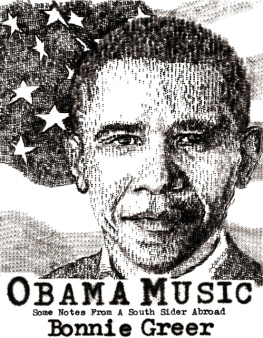Transforming America
Transforming America
Barack Obama in the White House
Edited bySteven E. Schier
Rowman & Littlefield Publishers, Inc.
Lanham Boulder New York Toronto Plymouth, UK
Published by Rowman & Littlefield Publishers, Inc.
A wholly owned subsidiary of The Rowman & Littlefield Publishing Group, Inc.
4501 Forbes Boulevard, Suite 200, Lanham, Maryland 20706
http://www.rowmanlittlefield.com
Estover Road, Plymouth PL6 7PY, United Kingdom
Copyright 2011 by Rowman & Littlefield Publishers, Inc.
All rights reserved . No part of this book may be reproduced in any form or by any electronic or mechanical means, including information storage and retrieval systems, without written permission from the publisher, except by a reviewer who may quote passages in a review.
British Library Cataloguing in Publication Information Available
Library of Congress Cataloging-in-Publication Data
Transforming America : Barack Obama in the White House / edited by Steven E. Schier.
p. cm.
Includes bibliographical references and index.
ISBN 978-1-4422-0178-1 (cloth : alk. paper) ISBN 978-1-4422-0179-8 (pbk. : alk.
paper) ISBN 978-1-4422-0180-4 (electronic)
1. United StatesPolitics and government2009 2. Obama, Barack. I. Schier,
Steven E.
E907.T73 2011
973.932092dc22
2011013336
 The paper used in this publication meets the minimum requirements of American
The paper used in this publication meets the minimum requirements of American
National Standard for Information SciencesPermanence of Paper for Printed Library
Materials, ANSI/NISO Z39.48-1992.
Printed in the United States of America
To
Steven Poskanzer
President, Carleton College
Introduction
Obamas Big Bang Presidency
Steven E. Schier
In his 2010 State of the Union address, Barack Obama made clear the magnitude of his presidential ambitions: From the day I took office, Ive been told that addressing our larger challenges is too ambitious; such an effort would be too contentious. Ive been told that our political system is too gridlocked, and that we should just put things on hold for a while. For those who make these claims, I have one simple question: How long should we wait? How long should America put its future on hold? Obamas answer, fully evident in his approach to governance, was no longer.
Many presidents initially enter office with grand ambitions, but no recent president has matched the scale of Obamas transformative plans. Domestically, they included a government restructuring of a health-care system comprising one-sixth of the nations economy, the largest public investment program for economic stimulus in Americas history, a far-reaching cap-and-trade system of emissions controls to combat climate change, a thorough reshaping of governmental regulation of the financial sector, comprehensive immigration reform, revoking the Dont Ask, Dont Tell policy for gays in the military, and a major revamping of the federal financial role in education policy. In foreign policy, Obama promised to reset Americas relations with many nations and regions of the world. He favored greater accommodation with Russia and Europe, a new overture of friendship with the Muslim world, a stronger focus on nuclear proliferation, and a successful resolution of Americas military involvement in Iraq and Afghanistan.
Obamas ambitions inevitably made him a highly polarizing figure for Americans, just as his predecessor George W. Bush, also a person of grand ambitions, had been. Like Bush, Obama led by acting as a national clarifier of differences between him and his partisan opponents. John F. Harriss description of Bushs leadership style fits Obama rather well: rather than blurring lines, illuminate and even exaggerate them. Rather than try to reassure opponents, antagonize themat least on issues in which he believed he could excite his own supporters in even greater measure (Harris 2009, 6768).
A Directive Presidency
This clarifying style is a characteristic of a directive presidency, defined by political scientists George C. Edwards III and Stephen Wayne:... the president is the director of change, who creates opportunities to move in new directions and leads others where they otherwise would not go. In this view, the president is out front, establishing goals and encouraging others inside and outside of government to follow. Accordingly, the president is the moving force of the system and the initiator of change (Edwards and Wayne 2009, 19). This approach, again similar to that of his immediate predecessor, holds the possibility of big changes, which Barack Obama has ardently pursued in the White House, but also entails large political risks.
A safer course, according to Edwards and Wayne, is for a president to act as a facilitator who builds coalitions, exploiting opportunities to help others go where they want to go anyway or at least do not object to going (2009, 20). Bill Clinton, who hugged the political center during much of his presidency and worked productively with Republican Congresses, was the archetypical facilitator, willing to settle for limited policy changes. A facilitator settles for narrower influence, but Obama, given his large Democratic majorities in Congress in 2009, had bigger goals in mind. No small ball for Obama. Nicol C. Rae argues in his chapter that Obama sought a political reconstruction that would create a lasting Democratic regime in the same fashion that Ronald Reagan revived GOP fortunes in the 1980s.
What led Obama to pursue a directive, clarifying presidency? The sweeping Democratic electoral victories in 2008 no doubt emboldened him, but certain personal qualities also fueled his big ambitions. Obamas public career consistently involved advocacy of strongly liberal principles, an approach that he carried with him into the White House. By 2010, the American public identified him as clearly on the left of the political spectrum. One 2010 survey by the Democracy Corps, a Democratic polling firm, found that 55 percent of registered voters thought the term socialist accurately described his ideological orientation (Greenberg Quinlan Rosner Research 2010).
Given his confident possession of liberal ideological convictions, a directive, clarifying leadership in their pursuit followed. Obamas academic background had given him a critical, analytic temperament, contributing to a policymaking style in which he worked from his ideological principles to a policy proposal. As journalist Jonathan Alter put it in his book on the Obama White House, Obama was a deductive thinker with a vertical mind. He thought deeply about a subject, organized it lucidly into point-by-point arguments for a set of policies or a speech and then said, here are my principles and here are some suggestions for fleshing out the details (Alter 2010, 212).
Obamas management style also encouraged dogged pursuit of his principle-based priorities. Obamas approach contrasted with that of Democratic predecessor Bill Clinton, whose more horizontal thinking contemplated a wide range of principles and alternatives and whose White House organization at times suffered from consequent disorganization. Barack Obama would have none of that. Early on in his presidency, he opted for a hierarchical White House organization with a strong chief of staff, a format usually favored by GOP presidents and by his predecessor George W. Bush. This style of organization facilitated the persistent pursuit of the presidents goals.
Big Changes
Working with a kindred congressional leadership and large Democratic majorities in Congress in 2009 and 2010, Obamas directive, clarifying leadership racked up a remarkable number of policy accomplishments during the early months of his presidency. PolitiFact.com, the award-winning research site of the St. Petersburg Times , charted Obamas success with 505 campaign promises. During his presidencys first 18 months, the president had only broken 3 of them, while keeping 119 and compromising on 35, with 245 in the works and only 45 stalled (PolitiFact 2010). Among those promises kept were major changes in public policy: the first comprehensive health-care reform since 1965, the largest public investment program ever, sweeping reform of financial regulation, a new federal hate crimes law, and a nuclear arms reduction pact with Russia.













 The paper used in this publication meets the minimum requirements of American
The paper used in this publication meets the minimum requirements of American